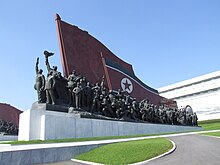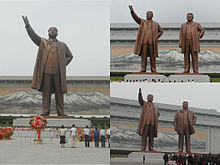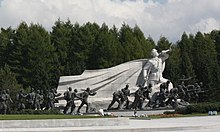Mansudae major monument
| Portrait of the great monument Mansudae after the renovation in 2012 | |
|---|---|
| Korean alphabet : | 만수대 대형 동상 |
| Hanja : | 万寿 台 大型 銅像 |
| Revised Romanization : | Mansudae Daehyeongdongsang |
| McCune-Reischauer : | Mansudae Taehyŏngdongsang |
The Mansudae large monument in the Chung-guyŏk district of the North Korean capital Pyongyang is a monument to commemorate the independence movement under Kim Il-sung (1912-1994) against Japanese rule over Korea .
description
The monument is several stairways accessible and covers an area of 240,000 square meters. The center is formed by two bronze figures of Kim Il-sung and Kim Jong-il about 20 meters high . The two statues are the largest monuments erected in North Korea to date for former heads of state.
To the left and right of the central bronze figures there are waving stone flags with a length of 50 meters and a height of 22.80 meters. A total of 228 statues up to five meters high are positioned around it. The 119 figures in the right group are supposed to represent the historical freedom struggle of the Korean people. The 109 figures in the left group symbolize the socialist revolution and the building of the new society in the DPRK.
In the background of the monument is the Korean Revolution Museum, originally founded in 1955 , which moved to Mansu Hill ( Mansudae ) in 1961 and was reopened in 1972 after a fundamental redesign. Its facade complements the large monument with a wall mosaic 70 meters long and 12.85 meters high . Depicted on it is the paektusan - the symbol of Kim Il-sung's struggle for Korea's independence from the Japanese Empire and for the glorified rule of the Kim family.
history
The monument was built on Mansu Hill by the construction company Mansudae Overseas Projects and inaugurated in April 1972 on the 60th birthday of the then head of state. This was originally coated with gold leaf . However, after criticism from the Chinese government, which supported North Korea financially at the time, the gold layer was removed again.
In 1995, the monument was juxtaposed with the Monument to the Establishment of the Labor Party of Korea . It is located at the same level on the other bank of the Taedong-gang and, together with the large Mansudae monument, forms a monumental axis in the overall urban design.
Until April 2012, a single statue of Kim Il-sung stood in the center of the monument. On the occasion of Kim Il-sung's 100th birthday , a double statue of Kim Il-sung and Kim Jong-il was inaugurated on April 13, 2012, the day of the sun . The original statue of Kim Il-sung was replaced by a new one. Instead of the Mao suit , Kim Il-sung is now shown in business clothes. He also wears glasses and smiles. However, the characteristic arm extended forward was retained. The statue of Kim Jong-il standing next to it shows him in a coat and his typical uniform-like blazer. The inauguration took place as part of a solemn ceremony in the presence of around 150,000 people.
In September 2012 the statues were veiled again. The statue of Kim Jong-ils was replaced by a new figure in February 2013. Instead of a coat as before, he now wears his typical anorak .
meaning
The large monument is one of the most important places of the personality cult around the "Great Leader" and "Eternal President" Kim Il-sung and the "Eternal Secretary General" and "Eternal Chairman of the National Defense Committee" Kim Jong-il. It is visited by North Koreans in homage and demonstrated to most Pyongyang visitors. Collective ceremonies are also held in front of the monument as part of large festive rallies or national holidays, such as the Day of the Founding of the Labor Party of Korea .
The design and placement of the monument, with its central location on the Mansu Hill and the overall monumental complex, are based on the specifications that Kim Jong-il laid down in his 1991 book On Architecture :
"In architectural spatial construction, the portrait of the Führer must rule over all spatial elements, and all structural elements must be subordinate to the expression of his portrait."
“Since a monument that praises the greatness of the Führer has a rich and deep content of ideas, it has to be gigantic. The shape of a building is of great importance. "
“To properly erect the bronze statue of the Führer in a city is an important question in the design of the city. This enables the citizens (...) to enjoy a meaningful existence in the security of their leader. "
The groups of statues on the sides are supposed to symbolize a struggle of the people of Chōsen for independence from the Japanese Empire and to remind of the socialist and revolutionary structure of society.
Reverent behavior is expected on site. As a gesture of respect, visitors are encouraged to lay flowers in front of the double statues of Kim Il-sung and Kim Jong-ils and to bow. Photographers are asked to take pictures of the statue in its entirety and not in part.
Comparable monuments
Several other monuments with a comparable purpose exist in various cities in North Korea in the style of the Mansudae giant monument. There are several hundred larger than life bronze statues of Kim Il-sung across the country. For example, in the center of the city of Kaesŏng , at its highest point, Mount Chanam, there is a bronze monumental statue of Kim Il-sung. The Battle Victory Monument in the Musan area is also comparable . In December 2013, a double statue corresponding to the Mansudae monument was inaugurated in Wonsan .
The Samjiyon Large Monument near Paektusan in Samjiyon District was built about seven years after the Mansudae Large Monument, in May 1979. It also resembles the Pyongyang Monument because of its group of figures on the side, which, however, only consist of fighting soldiers. The central figure shows Kim Il-sung with jodhpurs , boots and binoculars in his right hand. There is also a Juche tower on Monumental Square, comparable to the tower of the Pyongyang monument of the Chuch'e ideology .
On October 11, 2011 , two bronze statues depicting the former North Korean rulers were unveiled in Kanggye , the capital of Chagang-do Province . They also show Kim Il-sung with binoculars in his right hand and an outstretched left arm and Kim Jong-il with an anorak blowing in the wind. Previously there was only a single statue of Kim Il-sung.
See also
Web links
Individual evidence
- ↑ Rodong Sinmun, March 14, 2012
- ↑ a b Philipp Meuser (ed.): Architectural Guide Pyongyang. Volume 1: Photos and Descriptions. DOM publishers, Berlin 2011, ISBN 978-3-86922-126-7 , p. 111.
- ^ A b Large monument on Mansu Hill ( Memento from August 20, 2011 in the Internet Archive ) North Korea illustrated book, contemporary stories on Spiegel-Online
- ^ Korean Revolutionary Museum, Pyongyang: Foreign Languages Publishing House, 1963, p. 1
- ^ Arno Maierbrugger: North Korea Handbook. On the move in a mysterious land . 2nd, updated and expanded edition. Trescher, Berlin 2007, ISBN 978-3-89794-114-4 , pp. 110 ( limited preview in Google Book search).
- ↑ Mansudae Grand Monument lonelyplanet.com
- ↑ Rodong Sinmun, March 14, 2012
- ↑ Tages-Anzeiger, September 13, 2012 [1]
- ↑ ( Page no longer available , search in web archives: Largest Kim Jong-il Statue Unveiled in Pyongyang ), RIA Novosti (English)
- ↑ Unveiling of the new statues
- ↑ Mansu Hill statue drama ... ( Memento from February 18, 2013 in the web archive archive.today ) theworldnet.info from September 25, 2012
- ↑ North Korea gives Kim Jong-il new bronze jacket for giant statue , telegraph.co.uk, February 10, 2013
- ↑ ( Page no longer available , search in web archives: North Korean News Broadcast: October 10th, Juche 101 (2012) - Party Foundation Day ), (Korean)
- ↑ Kim Jong-il : On Architecture ( Memento from August 31, 2018 in the Internet Archive ), 1991
- ↑ A strange journey through the realm of the Kims tagesanzeiger.ch from September 15, 2012
- ^ Rüdiger Frank : North Korea. Deutsche Verlags-Anstalt, Munich 2014, page 61, ISBN 978-3-421-04641-3 .
- ↑ ( page no longer available , search in web archives: Victory monument of the battle in Musan area ), naenara.com.kp
- ↑ Statues of Kim Il Sung and Kim Jong Il Erected in Wonsan ( Memento from December 25, 2013 in the Internet Archive ) , KCNA from December 22, 2013
- ↑ ( Page no longer available , search in web archives: New Statues of Kim Il Sung and Kim Jong Il in Wonsan ) , video of the unveiling ceremony
- ↑ Samjiyon Grand Monument ( Memento of March 12, 2014 in the Internet Archive ), KCNA of October 27, 2011
- ↑ ( page no longer available , search in web archives: official video report of the KCNA about the unveiling of the statues ), (Korean)
Coordinates: 39 ° 1 ′ 55.6 ″ N , 125 ° 45 ′ 11 ″ E





